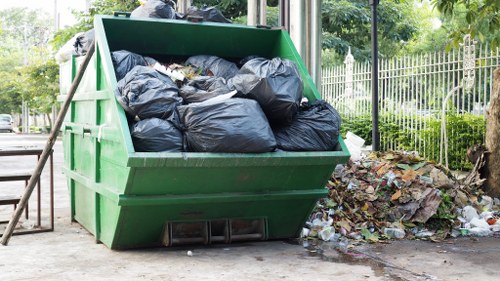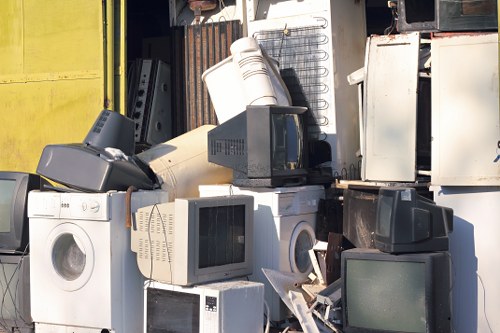Comprehensive Guide to Builders Waste Clearance in Eltham

When undertaking any construction or renovation project in Eltham, managing builders waste effectively is crucial. Not only does proper waste clearance ensure a clean and safe working environment, but it also contributes to environmental sustainability. Builders waste, also known as construction debris, includes materials like concrete, bricks, timber, metal, and other remnants resulting from building activities.
Eltham, with its growing infrastructure and housing developments, faces increasing challenges in handling and disposing of construction waste. Efficient waste clearance services are essential to address these challenges, ensuring that construction sites remain organized and compliant with local regulations.
Understanding the importance of builders waste clearance can help property owners, contractors, and builders make informed decisions. This guide delves into the nuances of waste management in Eltham, highlighting the best practices, regulatory requirements, and benefits of professional waste clearance services.

The Importance of Builders Waste Clearance
Effective builders waste clearance is not just a regulatory requirement but also a vital aspect of sustainable construction practices. Proper disposal minimizes the environmental impact, reduces the risk of accidents on construction sites, and ensures that reusable materials are recycled or repurposed.
In Eltham, waste management practices are governed by local councils that mandate specific guidelines for waste disposal. Non-compliance can result in hefty fines and project delays, making it imperative for builders to adhere to these standards.
Moreover, organized waste clearance enhances the overall efficiency of construction projects. It allows workers to navigate the site safely, reduces the likelihood of project overruns due to waste accumulation, and fosters a professional image for the construction company.

Types of Builders Waste
Builders waste can be broadly categorized into several types, each requiring specific handling and disposal methods:
- Concrete and Bricks: These are heavy materials that can be crushed and recycled for use in new construction projects.
- Timber: Untreated wood can be reused or recycled, while treated timber may require special disposal methods due to chemical treatments.
- Metals: Scrap metal is highly recyclable and can be processed to extract valuable materials.
- Plastics: Various plastic materials can be recycled, reducing the environmental footprint of construction activities.
- Mixed Waste: Often, construction sites produce a mix of different waste types, necessitating comprehensive waste management strategies.

Local Regulations in Eltham
Eltham adheres to strict waste management regulations to ensure that builders waste is handled responsibly. These regulations are designed to protect the environment, public health, and the aesthetic appeal of the area.
Key regulatory aspects include:
- Permits and Licensing: Builders must obtain the necessary permits before commencing waste disposal activities.
- Waste Classification: Proper classification of waste types is required to determine the appropriate disposal methods.
- Recycling Requirements: A certain percentage of waste must be recycled, promoting the use of sustainable materials.
- Reporting and Documentation: Accurate records of waste generation and disposal must be maintained to ensure compliance and facilitate audits.

Benefits of Professional Waste Clearance Services
Engaging professional builders waste clearance services in Eltham offers numerous advantages:
- Compliance: Professionals are well-versed in local regulations, ensuring that waste disposal practices meet all legal requirements.
- Efficiency: Experienced providers can manage waste clearance swiftly, minimizing disruptions to construction schedules.
- Environmental Responsibility: Expert services prioritize recycling and sustainable disposal methods, reducing the environmental impact of construction projects.
- Cost-Effectiveness: Proper waste management can lead to cost savings by reducing disposal fees and minimizing material wastage.
- Safety: Eliminating excessive waste reduces hazards on construction sites, protecting workers from accidents and injuries.
Choosing the Right Waste Clearance Service in Eltham
Selecting a reliable waste clearance service is critical to the success of your construction project. Here are key factors to consider:
- Experience: Look for companies with a proven track record in managing builders waste clearance in Eltham.
- Range of Services: Ensure the provider offers comprehensive services, including waste collection, sorting, recycling, and disposal.
- Recycling Capabilities: Choose services that prioritize recycling and sustainable disposal methods.
- Cost Transparency: Opt for companies that provide clear and upfront pricing without hidden fees.
- Customer Reviews: Positive testimonials and reviews indicate reliability and quality of service.
By carefully evaluating these factors, you can select a service that aligns with your project needs and sustainability goals.

Steps Involved in Builders Waste Clearance
Understanding the waste clearance process can help in planning and executing efficient waste management strategies. The typical steps include:
- Assessment: Evaluating the volume and types of waste generated to determine the appropriate disposal methods.
- Collection: Gathering waste materials from the construction site in an organized manner.
- Segregation: Sorting waste into different categories for recycling or disposal.
- Transport: Moving the sorted waste to designated recycling centers or disposal facilities.
- Documentation: Maintaining records of waste handling for compliance and tracking purposes.

Environmental Impact of Improper Waste Disposal
Failing to manage builders waste effectively can have severe environmental consequences, including:
- Soil and Water Contamination: Hazardous materials can leach into the soil and water sources, harming ecosystems and public health.
- Air Pollution: Decomposing waste can release harmful gases, contributing to air quality degradation.
- Resource Depletion: Not recycling materials leads to the unnecessary consumption of natural resources.
- Increased Greenhouse Gas Emissions: Improper disposal, especially of organic waste, can result in higher greenhouse gas emissions.
Taking proactive measures in waste clearance helps mitigate these impacts, promoting a healthier environment.

Innovative Waste Management Solutions in Eltham
Eltham is embracing innovative strategies to enhance builders waste clearance, ensuring sustainability and efficiency. Some of these solutions include:
- Recycling Programs: Establishing dedicated recycling initiatives for different waste categories to maximize material recovery.
- Waste-to-Energy: Converting non-recyclable waste into energy through advanced technologies, reducing landfill dependency.
- Digital Tracking Systems: Utilizing software to monitor waste generation, collection, and disposal, enhancing transparency and accountability.
- Collaborative Partnerships: Forming alliances with recycling centers, environmental organizations, and local authorities to streamline waste management processes.
These innovative approaches are setting new standards for builders waste clearance in Eltham, fostering a culture of sustainability.

Cost of Builders Waste Clearance in Eltham
Managing the cost of waste clearance is a significant concern for many construction projects. Several factors influence the overall expenses, including:
- Volume of Waste: Larger projects generate more waste, leading to higher clearance costs.
- Type of Waste: Hazardous or non-recyclable waste may incur additional disposal fees.
- Service Frequency: Regular waste collection services can be more cost-effective compared to sporadic pickups.
- Distance to Disposal Sites: Proximity to recycling or disposal facilities can affect transportation costs.
- Regulatory Compliance: Adhering to local waste management regulations may involve additional expenses.
To manage costs effectively, it's advisable to work with waste clearance providers that offer tailored solutions and transparent pricing structures.

Sustainable Practices in Builders Waste Clearance
Sustainability is at the forefront of modern construction, and builders waste clearance plays a pivotal role in this paradigm. Implementing sustainable practices ensures that construction activities contribute positively to environmental conservation.
- Material Recycling: Prioritizing the recycling of materials like metal, wood, and concrete reduces the demand for virgin resources.
- Minimizing Waste Generation: Efficient project planning and material management can significantly reduce the amount of waste produced.
- Eco-friendly Disposal Methods: Utilizing disposal techniques that have minimal environmental impact, such as composting organic waste.
- Green Certification: Achieving certifications for sustainable waste management can enhance the reputation of construction projects.
Adopting these practices not only benefits the environment but also aligns with the growing demand for eco-conscious construction solutions.

Challenges in Builders Waste Clearance
Despite the availability of professional waste clearance services, several challenges persist in managing builders waste effectively in Eltham:
- Limited Recycling Facilities: Availability of adequate recycling centers can restrict the capacity to manage and recycle waste materials.
- Regulatory Changes: Keeping up with evolving waste management regulations requires continuous adaptation and compliance efforts.
- Cost Constraints: Budget limitations can hinder the ability to invest in comprehensive waste management solutions.
- Awareness and Training: Lack of awareness among construction workers about sustainable waste practices can lead to inefficient waste handling.
- Logistical Issues: Coordinating waste collection and disposal schedules with construction activities can be complex and time-consuming.
Addressing these challenges requires a collaborative approach involving builders, waste management providers, and local authorities.

Future Trends in Builders Waste Clearance
The landscape of builders waste clearance in Eltham is poised for significant advancements, driven by technological innovations and increasing environmental awareness. Future trends include:
- Automation and AI: Leveraging artificial intelligence to optimize waste sorting and recycling processes.
- Circular Economy: Embracing a circular economy model where materials are reused and recycled continuously, minimizing waste.
- Smart Waste Management Systems: Implementing IoT-based systems for real-time monitoring and management of construction waste.
- Green Building Certifications: Increased emphasis on achieving certifications that recognize sustainable construction and waste management practices.
- Community Engagement: Involving local communities in waste reduction initiatives to foster a collective responsibility towards sustainability.
These trends are set to transform builders waste clearance, making it more efficient, sustainable, and aligned with global environmental goals.

How to Reduce Builders Waste
Reducing builders waste involves strategic planning and the adoption of best practices throughout the construction process. Here are some effective methods:
- Precise Planning: Detailed project planning can help anticipate waste generation and implement measures to minimize it.
- Material Optimization: Using materials efficiently and opting for prefabricated components can reduce excess waste.
- Training and Education: Educating workers about waste reduction techniques and the importance of sustainable practices.
- Reuse of Materials: Salvaging materials from demolition sites for use in new construction projects.
- Regular Audits: Conducting waste audits to identify areas for improvement and track progress in waste reduction efforts.
Implementing these strategies not only reduces waste but also enhances the overall sustainability and cost-effectiveness of construction projects.

Case Studies: Successful Waste Clearance in Eltham
Examining real-world examples of effective builders waste clearance can provide valuable insights and inspire best practices. Here are a few case studies from Eltham:
Project A: Residential Development
A residential project in Eltham partnered with a professional waste clearance service to manage construction debris. By implementing a robust recycling program and optimizing waste collection schedules, the project achieved a 50% reduction in landfill waste. The success was attributed to meticulous planning, worker training, and continuous monitoring.
Project B: Commercial Building
A commercial building project faced challenges in managing diverse waste types. By utilizing advanced sorting technologies and collaborating with multiple recycling facilities, the project effectively diverted significant amounts of waste from landfills. The initiative not only enhanced environmental sustainability but also earned the project a green certification.
Project C: Renovation Project
A major renovation project in Eltham emphasized material reuse and recycling. Salvaged materials were repurposed within the project, reducing the need for new resources and lowering disposal costs. This approach demonstrated the feasibility and benefits of sustainable waste management in renovation activities.

Best Practices for Builders Waste Clearance
Adhering to best practices ensures effective and sustainable builders waste clearance. Here are some recommendations:
- Comprehensive Waste Management Plan: Develop and implement a detailed waste management plan outlining roles, responsibilities, and procedures.
- Engage Stakeholders: Involve all project stakeholders, including workers, contractors, and waste clearance providers, in waste management initiatives.
- Invest in Recycling Infrastructure: Provide adequate facilities and equipment for waste sorting and recycling on-site.
- Monitor and Evaluate: Regularly assess waste management practices to identify areas for improvement and celebrate successes.
- Stay Informed: Keep abreast of the latest regulations, technologies, and trends in builders waste clearance to continuously enhance practices.
Implementing these best practices fosters a culture of sustainability and ensures efficient waste clearance in construction projects.

Conclusion
Builders waste clearance is a critical component of construction projects in Eltham, influencing environmental sustainability, regulatory compliance, and project efficiency. By understanding the types of waste, adhering to local regulations, and leveraging professional waste management services, builders can effectively manage construction debris.
Embracing sustainable practices and innovative solutions not only mitigates the environmental impact but also enhances the overall success of construction endeavors. As Eltham continues to grow, prioritizing effective builders waste clearance will be paramount in fostering a sustainable and thriving community.
Contact us today to learn more about our builders waste clearance services in Eltham and how we can support your construction projects with efficient and sustainable waste management solutions.
